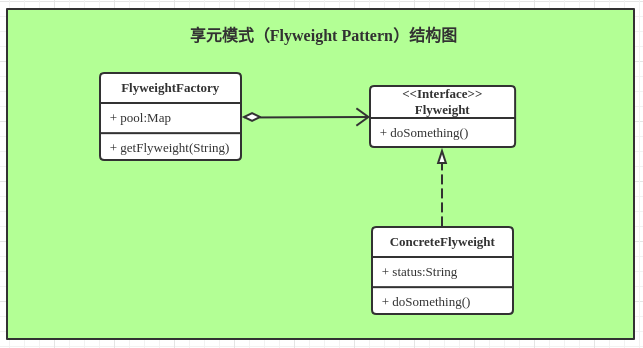设计模式之享元模式
享元模式
-
享元模式结构图

-
示例代码
// 抽象享元角色 public interface Flyweight { void doSomething(); } // 具体享元角色 public class ConcreteFlyweight implements Flyweight{ private String status; public ConcreteFlyweight(String status) { this.status = status; } @Override public void doSomething() { System.out.println("开始工作,状态:" + status); } } // 享元工厂 public class FlyweightFactory { private Map<String, Flyweight> pool = new HashMap<>(); public Flyweight getFlyweight(String status){ if (!pool.containsKey(status)){ System.out.println("新建享元模式对象"); pool.put(status, new ConcreteFlyweight(status)); } return pool.get(status); } public int getSize(){ return pool.size(); } } // 测试类 public class FlyweightTest { public static void main(String[] args) { FlyweightFactory factory = new FlyweightFactory(); Flyweight f1 = factory.getFlyweight("忙碌"); Flyweight f2 = factory.getFlyweight("轻松"); Flyweight f3 = factory.getFlyweight("魔域"); Flyweight f4 = factory.getFlyweight("忙碌"); System.out.println(factory.getSize()); } } -
总结:
优点:减少了对象的创建,降低了资源的消耗,提供效率;
缺点:关注内外部状态,关注线程安全问题,使系统逻辑复杂化.





【推荐】国内首个AI IDE,深度理解中文开发场景,立即下载体验Trae
【推荐】编程新体验,更懂你的AI,立即体验豆包MarsCode编程助手
【推荐】抖音旗下AI助手豆包,你的智能百科全书,全免费不限次数
【推荐】轻量又高性能的 SSH 工具 IShell:AI 加持,快人一步
· 从 HTTP 原因短语缺失研究 HTTP/2 和 HTTP/3 的设计差异
· AI与.NET技术实操系列:向量存储与相似性搜索在 .NET 中的实现
· 基于Microsoft.Extensions.AI核心库实现RAG应用
· Linux系列:如何用heaptrack跟踪.NET程序的非托管内存泄露
· 开发者必知的日志记录最佳实践
· winform 绘制太阳,地球,月球 运作规律
· TypeScript + Deepseek 打造卜卦网站:技术与玄学的结合
· AI 智能体引爆开源社区「GitHub 热点速览」
· 写一个简单的SQL生成工具
· Manus的开源复刻OpenManus初探